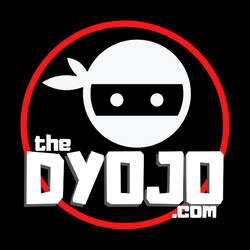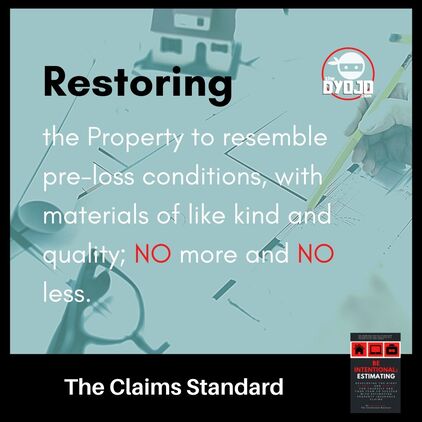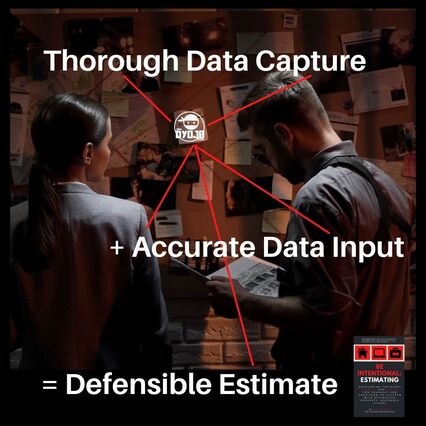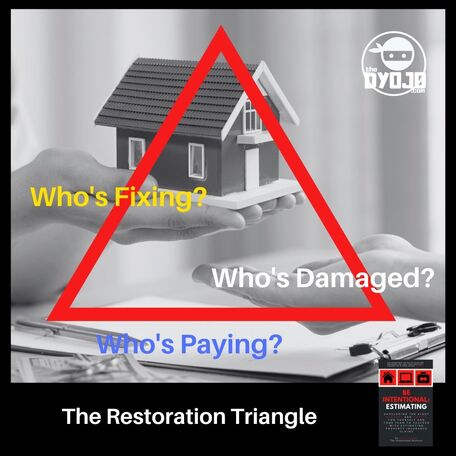|
How a project starts is critical to set it on the right path to producing a positive customer experience and a profitable conclusion. A contract forms the legal agreement between a willing buyer (the customer) and a willing seller (the contractor). The contract is built upon the foundation laid from a clearly defined agreed-upon scope of work. What is and, as importantly, what is not included in that scope of work is outlined in the contractor’s estimate. Let’s discuss three guiding principles for better project outcomes. Element 1 - The Claims StandardThe Claims Standard is a guiding principle for all members of your team, and it crystallizes the responsibilities of all parties in the insurance claims relationship. Restoring the property to resemble pre-loss conditions, with materials of like kind and quality; no more and no less. Your initial site inspection identifies the affected areas related to the source and extent of the damages.
If everyone on your team understands and continues to frame the project in accordance with The Standard, all parties will have a clearer understanding of the parameters for success. I believe that when you properly implement this simple narrative into your process, from the outset, you can help steer the project lifecycle more consistently to a successful outcome (habit). Setting the expectations at this point in the project sets the team up to execute realistic expectations during production. Element 2- A Simple Estimating FormulaEstimating is the process of establishing the agreed-upon scope and cost for a given project. As contractors, we utilize a simple estimating formula to guide our process: Thorough Data Capture (TDC) + Accurate Data Input (ADI) = A Defensible Estimate (ADE) If you are struggling to produce consistently positive project outcomes, you should review whether your data inputs (estimate) are accurate as well as whether your data capture (documentation) is thorough. You must take accountability for this truth: The quality of the data inputs (composed estimate) is in direct correlation to the quality of the data captured. Everyone on the team should understand the importance of gathering and sharing quality documentation from the worksite. To tie these two elements together, the estimator will do everyone a favor by making the previously mentioned Standard clear at the outset of every claim. Your introduction could be something to the effect of, “My job is to perform thorough data capture of the site conditions so that I can accurately data input to generate an estimate for an agreed-upon scope (most likely through Xactimate) to restore your property to resemble pre-loss conditions.” Many customers choose to upgrade materials or use the damage scenario as a time to finally make those remodeling changes that they have been contemplating for months. Before a restoration contractor can bid the changes to the client, everyone needs to be clear on what is part of the insurance scope so the proper charges are going to the correct parties. Element 3 - The Restoration TriangleThroughout his career, Pete Consigli, The Global Restoration Watchdog, trained restorers to value the Restoration Triangle. Each party brings something unique to the table that should be heard and referenced as the agreed-upon scope is established:
Pete reminds stakeholders, “If one of these parties is left out of the process of determining and agreeing on the extent of damage, scope of repair, cost of restoration to a pre-loss condition, timelines, and criteria for satisfactory completion, then there will be problems.” A claim should not follow the narrative of a T.V. drama or a strategy for Survivor, whereby two members of the triangle team up to push their narrative through. For example, the contractor and client should not be in cahoots to figure out a way to “maximize the claim” without justification. This is fraud. Neither should the contractor and the carrier be working together to dwindle the scope. This is short-changing (and likely grounds for bad faith). Developing Your Estimating ProcessBetter project outcomes start with better project initiation. As an owner or manager, if you want accountability within your systems, you need to ensure your processes are clear and consisstenlty followed. As an estimator, you need to acknowledge your role in setting up your team for success. As a team, everyone has to work together if the process is going to improve. We know there are two primary goals,1) produce a happy customer, hopefully resulting in repeat and referral business (the best kind), and 2) a profitable project so that we can invest in people and growth. My soon-to-be-released fourth book, How Not To Such At Estimating, will also be a course delivered through Restoration Technical Institutes' learning platform. The content is designed to help restoration professionals develop Habits for Better Project Outcomes. I will share at least 3 more elements to add to your estimating toolbag. If you are interested in peer-reviewing a chapter or would like to be considered to win one of 12 FREE copies for aspiring intentional estimators, please contact The DYOJO through the book's landing page.
0 Comments
Leave a Reply. |
Words
The DYOJO - helping contractors shorten Archives
June 2024
Categories
All
EstimatingMarketingInsurance ClaimsLeadership |
|
| |||||||




 RSS Feed
RSS Feed
